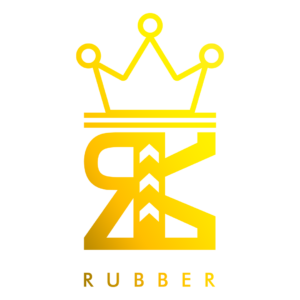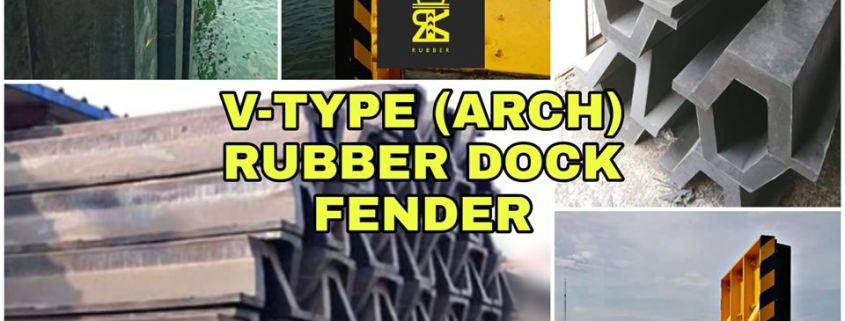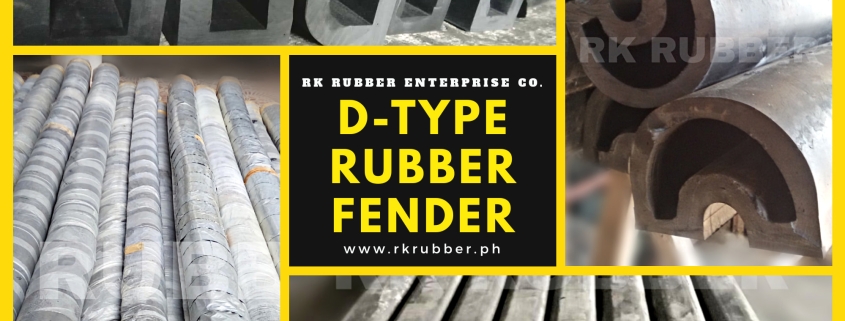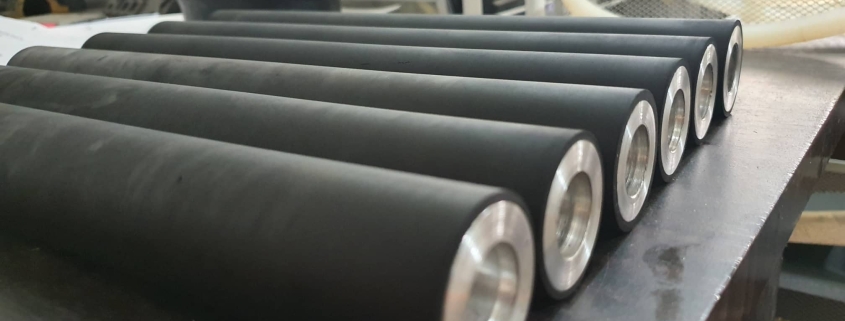Arch Rubber Dock Fender
Welcome to our article on RK Rubber Philippines, the leading manufacturer of Arch Rubber Dock Fenders in the Philippines. With a nationwide presence, our company is dedicated to providing high-quality rubber product solutions. Our Arch Rubber Dock Fenders, also known as V fenders, offer exceptional tear and shear resistance when fitted with a steel plate. With flexible installation options and customizable designs, our fenders prevent collisions between vessels and ports, making them an essential component of port infrastructure.
Key Takeaways
- Arch rubber dock fenders ensure the safety and structural integrity of port infrastructure.
- They provide excellent energy absorption capability, reducing impact force during vessel berthing.
- Arch rubber dock fenders minimize repair costs and extend the lifespan of infrastructure.
- RK Rubber Philippines is the leading arch rubber dock fender manufacturer in the Philippines with a strong reputation in the industry.
The Importance of Arch Rubber Dock Fenders in Port Infrastructure
Arch rubber dock fenders play a vital role in ensuring port infrastructure’s safety and structural integrity. These fenders offer numerous benefits for port operations. Firstly, they provide excellent energy absorption capability, reducing the impact force during vessel berthing and preventing damage to both the vessel and the dock. This helps to extend the lifespan of the infrastructure and minimize repair costs.
Maintenance tips for arch rubber dock fenders are relatively simple. Regular inspection is essential to identify any signs of wear or damage, such as cracks or deformations. Cleaning the fenders regularly with mild soap and water can help remove dirt and debris that may cause deterioration. Additionally, lubricating the fender’s mounting holes can prevent corrosion and ensure smooth installation and replacement.
Several case studies have demonstrated the effectiveness of arch rubber dock fenders in accident prevention. These studies highlight how the fenders absorb impact energy, minimizing the risk of vessel collisions and protecting both the dock and the vessel. Innovations in arch rubber dock fender design and technology continue to improve their performance and durability. These include using advanced materials, such as high-grade rubber compounds and steel reinforcement, to enhance tear and shear resistance.
When comparing arch rubber dock fenders to other types of dock fenders, they often outperform alternatives in energy absorption and cost-effectiveness. Their flexible installation options and low reaction force make them suitable for various port applications. Overall, arch rubber dock fenders are a reliable and efficient solution for ensuring the safety and longevity of port infrastructure.
Customization Options for Arch Rubber Dock Fenders
One can choose from various customization options to tailor arch rubber dock fenders according to their specific requirements. These customization options offer several benefits to the users. Firstly, the installation methods can be modified based on the docking infrastructure and the desired positioning of the fenders. The flexibility of installation options allows for horizontal or vertical fitting, depending on the specific needs of the dock.
Another customization option is the materials for the arch rubber dock fenders. Different materials such as EPDM, natural rubber, and synthetic rubber can be used to suit different applications and environments. The appropriate material selection is crucial to ensure optimal performance and durability of the fenders.
Additionally, design considerations can be customized to meet specific demands. The dimensions and shape of the fenders can be adjusted to accommodate different vessels and port requirements. Mounting holes can also be incorporated for easy installation or replacement of the fenders.
To maintain the longevity of the arch rubber dock fenders, regular maintenance is essential. Simple maintenance tips include regular cleaning and inspection for any signs of wear or damage. Prompt repairs or replacements should be carried out when necessary to ensure the fenders continue to provide effective protection.
The Role of Arch Rubber Dock Fenders in Preventing Accidents in Ports
Effective implementation of arch rubber dock fenders, coupled with regular maintenance and inspections, plays a pivotal role in minimizing accidents and ensuring the safety of ports. The benefits of using arch rubber dock fenders are numerous. These fenders have high energy absorption capability, which allows them to effectively absorb and distribute impact forces during vessel docking or berthing. This helps prevent damage to both the vessel and the port infrastructure.
Several case studies have shown the effectiveness of arch rubber dock fenders in preventing accidents. In one instance, a large container ship was approaching a port at high speed when it suddenly encountered a mechanical failure. Thanks to the arch rubber dock fenders, the impact was absorbed, preventing a potentially catastrophic collision.
Maintenance tips for arch rubber dock fenders include regular inspections for any signs of wear, tear, or damage. It is essential to promptly replace any damaged fenders to ensure continued protection. Comparing arch rubber dock fenders to other fenders, they offer a cost-effective solution with low reaction forces and easy installation.
Innovations in arch rubber dock fender technology have led to various designs and materials. These innovations have improved the durability and performance of the fenders, enabling them to withstand harsh weather conditions and provide reliable protection for ports.
Choosing the Right Class of Arch Rubber Dock Fender for Your Needs
When selecting the appropriate class of arch rubber dock fender for your specific requirements, it is important to consider various factors such as the size and weight of the vessels, the expected impact forces, and the environmental conditions of the docking area. The class of arch rubber dock fender refers to its design and functionality. There are three classes available: V1, V2, and V3.
The V1 class is suitable for smaller vessels and lighter impact forces. It provides moderate energy absorption and low reaction force. The V2 class is designed for medium-sized vessels and moderate impact forces. It offers higher energy absorption and slightly higher reaction force compared to V1. The V3 class is ideal for larger vessels and heavier impact forces. It has the highest energy absorption capability and reaction force.
When choosing the right class of arch rubber dock fender, consider the installation methods available. Arch rubber dock fenders can be installed horizontally or vertically, providing flexible options for different docking areas. Additionally, consider the material options available. Arch rubber dock fenders are available in different materials such as EPDM, natural rubber, and synthetic rubber, each with its own weather resistance properties.
Maintenance cost is another important factor to consider. Arch rubber dock fenders are known for their low-cost maintenance and long-lasting durability. They are designed to withstand harsh weather conditions, making them suitable for marine, engineering, and industrial applications.
How RK Rubber Philippines Became a Leading Arch Rubber Dock Fender Manufacturer in the Philippines
RK Rubber Philippines has emerged as the leading manufacturer of arch rubber dock fenders in the Philippines, providing high-quality products and exceptional service to meet the growing demand in the industry. One of the key factors that contributed to their success is their efficient manufacturing process. RK Rubber Philippines utilizes advanced machinery and equipment to ensure precise and consistent arch rubber dock fender production. They also have a strict quality control system to guarantee that every product leaving their facility meets the highest standards.
The market demand for arch rubber dock fenders has been steadily increasing due to the rise in maritime activities and the need for reliable port infrastructure. RK Rubber Philippines recognized this demand and capitalized on the opportunity to become a leading manufacturer in the country. They have invested in research and development to continuously improve their product offerings and stay ahead of the competition.
RK Rubber Philippines’ competitive advantage lies in its ability to provide customized solutions to its customers. They understand that each client has unique requirements and they strive to meet those needs by offering flexibility in design and dimensions. This level of customization sets them apart from other manufacturers in the industry.
Furthermore, customer satisfaction is at the core of RK Rubber Philippines’ business philosophy. They prioritize excellent customer service, ensuring that their clients receive prompt responses to inquiries and assistance throughout the purchasing process. By consistently delivering high-quality products and exceptional service, RK Rubber Philippines has gained the trust and loyalty of its customers, solidifying its position as the leading arch rubber dock fender manufacturer in the Philippines.
Frequently Asked Questions
Can the Arch Rubber Dock Fender Be Installed at an Angle Other Than Horizontal or Vertical?
The arch rubber dock fender can be installed at angles other than horizontal or vertical, but this may pose installation challenges, impact fender performance, affect safety considerations, and have structural implications. The cost-effectiveness of alternative angles should also be considered.
What Are the Different Materials Used for Manufacturing Arch Rubber Dock Fenders?
Arch rubber dock fenders are manufactured using EPDM, natural rubber, and synthetic rubber. These fenders offer high energy absorption capability and low reaction force, making them suitable for marine and industrial applications.
How Do Arch Rubber Dock Fenders Prevent Collisions Between Vessels and Ports?
Arch rubber dock fenders play a crucial role in maritime safety by preventing collisions between vessels and ports. The advantages of using arch rubber dock fenders include high energy absorption capability, low reaction force, and flexibility in installation options. Case studies highlight their effectiveness, while ongoing innovations continue to improve their technology. Comparatively, arch rubber dock fenders are cost-effective compared to other collision prevention methods.
Are Arch Rubber Dock Fenders Suitable for Use in Extreme Weather Conditions?
Arch rubber dock fenders are suitable for extreme weather conditions due to their high impact resistance, temperature stability, UV resistance, flexibility in extreme conditions, and durability in harsh weather.
What Are the Maintenance Requirements for Arch Rubber Dock Fenders to Ensure Their Long-Lasting Durability?
Regular maintenance is required to ensure the long-lasting durability of arch rubber dock fenders. This includes inspecting for damage, cleaning the fenders, and ensuring proper installation angles. Using high-quality manufacturing materials also contributes to their durability. Additionally, the fenders’ design and construction contribute to their suitability for preventing collisions and withstanding extreme weather conditions.
Conclusion
In conclusion, RK Rubber Philippines is the leading manufacturer of Arch Rubber Dock Fenders in the Philippines, offering high-quality and customizable solutions for various port infrastructure needs. With their durable materials and flexible installation options, these fenders play a crucial role in preventing accidents and protecting vessels and ports. RK Rubber Philippines has established itself as a trusted Arch Rubber Dock Fenders provider, ensuring exceptional performance and long-lasting durability in all weather conditions.




